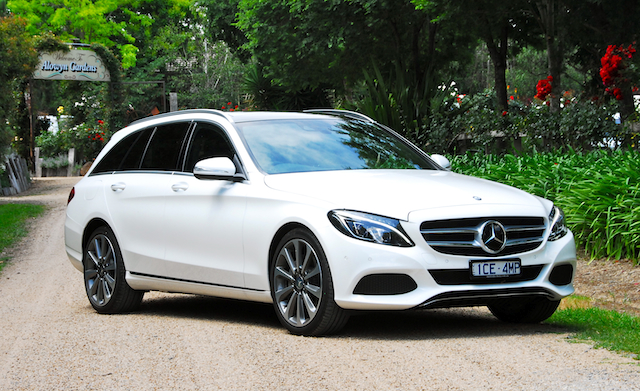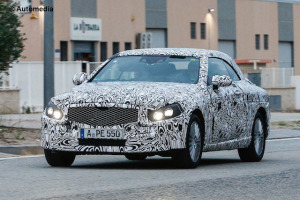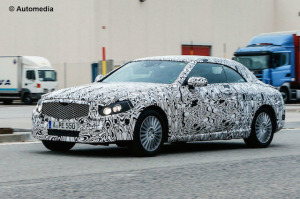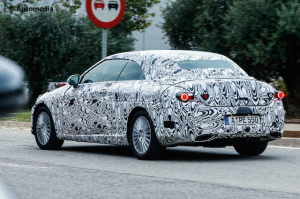
Mercedes-Benz is reportedly planning to introduce 19 new models between now and 2020, some of them refreshes of existing variants, others occupying new segments.
The M-Class SUV name goes, replaced by a G-Class variant … it’s more than ever a world of alphabet soup in the A-, B-, C-, E-, G-, S-Class and AMG model ranges.
A couple of those ‘new’ examples in the award-winning C-Class line-up are landing in New Zealand right now – the estate range (above) and C300 hybrid sedan. Another will be here next year – the C63 AMG sedan.
 Yet another is the two-door C-Class soft-top – shown under camouflage in three pictures here – likely to be available in 2016, perhaps after the two-door C-Class coupe and 4Matic C-Class estate. A plug-in hybrid C-Class sedan is also due, so is the ultra-thrifty C350 hybrid … the list goes on.
Yet another is the two-door C-Class soft-top – shown under camouflage in three pictures here – likely to be available in 2016, perhaps after the two-door C-Class coupe and 4Matic C-Class estate. A plug-in hybrid C-Class sedan is also due, so is the ultra-thrifty C350 hybrid … the list goes on.
Outside of the V8-powered C63 AMG and the likely appearance of a six-cylinder model here and there, the C-Class variants all use four-cylinder petrol and diesel engines in different states of tune and mated to a seven-speed automatic ‘box, the 7G-Tronic.
 That’s now. Later, the 7G-Tronic will be replaced by one with two extra ratios, the 9G-Tronic. The 9G-Tronic made its first public appearance in Germany last weekend, in an E-Class variant.
That’s now. Later, the 7G-Tronic will be replaced by one with two extra ratios, the 9G-Tronic. The 9G-Tronic made its first public appearance in Germany last weekend, in an E-Class variant.
Fuel savings over the seven-speeder are said to be marginal. So, too, C02 exhaust emissions. But the end game for Mercedes-Benz and all other carmakers is better fuel economy and thus fewer exhaust pollutants. Equipping popular model ranges with multi-ratio gearboxes mated to smaller-capacity turbocharged engines helps bring down a fleet’s average emissions.
 Take the latest C-Class arrivals, the estate and hybrid sedan. I drove them outside of Melbourne the other day. The three estate variants – petrol C200 and C250 and diesel C250 BlueTec – come with a $3000 premium over the sedan and share engines and equipment levels.
Take the latest C-Class arrivals, the estate and hybrid sedan. I drove them outside of Melbourne the other day. The three estate variants – petrol C200 and C250 and diesel C250 BlueTec – come with a $3000 premium over the sedan and share engines and equipment levels.
The C200 uses a 2.0-litre turbocharged four generating 135kw/300Nm. The C250 uses the same unit, tweaked to deliver 150kW/350NM. The C250 BlueTec (BlueTec is the name of a system that uses an ammonia additive to burn off harmful diesel soot in the exhaust) has a 2.1-litre diesel putting out 150kW/500Nm. Stop-start technology is standard.
The C300 hybrid sedan also uses the same diesel donk, in this case working with an electric motor and generator that adds 23kW/250Nm. But the marriage doesn’t deliver a maximum 173kW/750Nm – hybrids don’t work that way. More on the C300 further down the page.
The excellent ride/handling mix and overall refinement of the C-Class sedan (a 2014 car of the year winner in NZ and Australia) has been carried over to the estate. It also offers more room for occupants, a substantial 45mm of rear seat legroom along with more width and headroom. The car is 96mm longer and 40mm wider than the outgoing model. Wheelbase is longer, too, by 80mm.
The packaging is more versatile, offering a 40/20/40/ split for the folding rear seats compared with the previous car’s 60/40 split. The new configuration allows 1510 litres with the seats down, or 490 litres with them in use.
The estate has the same electronic modes – Comfort, ECO, Sport, Sport+, Individual –that allow the driver to adjust engine and gearbox responses and suspension and steering settings. Safety gear includes nine airbags and a bundle of driver aids, including fatigue detection, blind spot assistance and collision prevention.
Fuel economy of the estates is up slightly on the sedans, a minor disadvantage at best. Figure on between 6 and 8 litres/100km on a good day. I got 5.5 litres/100km (51.6mpg) on a 560km round trip in the petrol C250 sedan in Australia a few weeks ago. The BlueTec diesel can go under 5 litres/100km, says Benz.
On a brief drive around the Yarra Valley, the BlueTec is perhaps the most desirable estate, effortless under a light throttle, thanks to the 500Nm of torque. But the lower-powered C200 (NZ$74,900) adds driver enjoyment by noticeably responding to each engine/gearbox/suspension/steering adjustment. Such inputs by the driver seem to be less noticeable in the more powerful C250 (NZ$89,900) and C250 BlueTec (NZ$91,400).
The torque delivery in the diesel-electric C300 sedan (NZ$,94,900) is a highlight. The car is one of the few premium diesel hybrids on the road. Combining 500Nm of torque with the instant oomph from the electric motor helps to make it the fastest accelerating C-Class from a standing start and through the gears
But not at a cost – the C300 hybrid is the most fuel-thrifty C-Class, consuming a claimed 4.0 litres/100km, or 71mpg, despite its battery pack adding 120kg to the weight of its closest relative, the 1595kh C250 sedan. C02 emissions have been cut from 116gr/km to 105gr/km.
The hybrid’s battery pack sits under the rear left seatback. It robs some space from the 435-litre capacity boot, although the rear seatbacks tumble forward to boost loads. The battery pack eats into the fuel tank capacity, too, now at 50 litres.
But the benefits at the wheel outweigh the hybrid compromises. Move away from a standstill on a light throttle and the car runs on the electric motor alone; it can do so for about 1km. Speed up and the 2.1-litre diesel cuts in.
Add more speed, move from a Comfort setting to Sport or Sport +, and the C300 hunkers down on its rear-drive chassis and starts to thrive on a bundle of flexible torque. But sit at 100km/h on a motorway in the ECO mode with just the right throttle loading, and the electric motor can take over again. Result: zero emissions.
How do you know this? A power gauge among the instruments tells you so. It is the only visual giveaway, inside and out, that the C300 is a hybrid. There are no hybrid badges, no colour-coded shields. The gauge is a subtle reminder to the driver alone that the C300 is different.
LED bars indicate when the hybrid system is recharging the battery pack. That happens like all other hybrids, when the driver lifts off the throttle or applies the brakes. The bars also show when the electric motor contributes to the diesel engine’s torque.
The C300’s brakes are progressively firm, under light or heavy braking. That’s unusual for hybrids, even earlier Benz examples. Hybrids rely on electrics to pre-load the stoppers and that’s why they always feel spongy. Not the C300. Benz seems to have overcome that problem.
